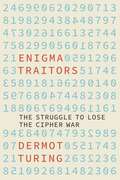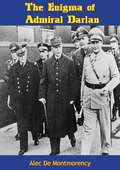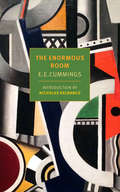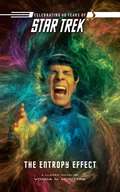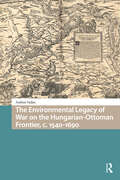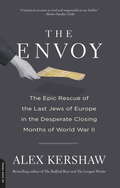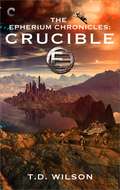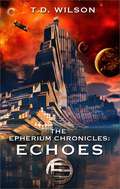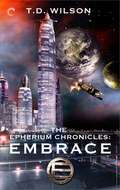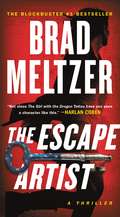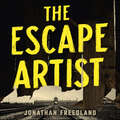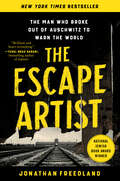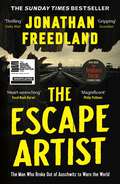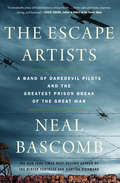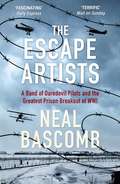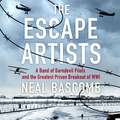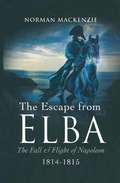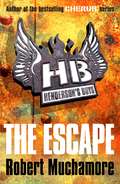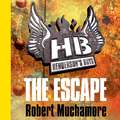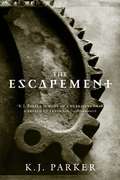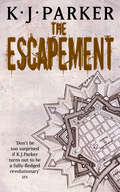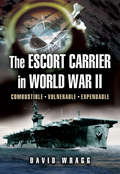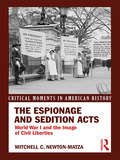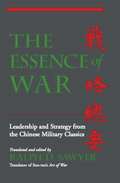- Table View
- List View
The Enigma Game
by Elizabeth Wein#1 New York Times bestselling author Elizabeth Wein delivers an exhilarating, unmissable thriller that finds three very different young adults united to decode a secret that could turn the tide of World War II. 1940. Facing a seemingly endless war, fifteen-year-old Louisa Adair wants to fight back, make a difference, do something-anything to escape the Blitz and the ghosts of her parents, who were killed by enemy action. But when she accepts a position caring for an elderly German woman in the small village of Windyedge, Scotland, it hardly seems like a meaningful contribution. Still, the war feels closer than ever in Windyedge, where Ellen McEwen, a volunteer driver with the Royal Air Force, and Jamie Beaufort-Stuart, a flight leader for the 648 Squadron, are facing a barrage of unbreakable code and enemy attacks they can't anticipate.Their paths converge when a German pilot lands in Windyedge under mysterious circumstances and plants a key that leads Louisa to an unparalleled discovery: an Enigma machine that translates German code. Louisa, Ellen, and Jamie must work together to unravel a puzzle that could turn the tide of the war--but doing so will put them directly in the cross-hairs of the enemy.Featuring beloved characters from Code Name Verity and The Pearl Thief, as well as a remarkable new voice, this brilliant, breathlessly plotted novel by award-winning author Elizabeth Wein is a must-read.
The Enigma Traitors: The Struggle to Lose the Cipher War
by Dermot TuringEveryone knows the story of Enigma and secret codebreaking in the Second World War: the triumph of Bletchley Park over world-class cipher technology. Except that excellence in codebreaking was nearly betrayed by incompetence in codemaking.German codebreakers were effective and Allied codes and ciphers were weak. With both sides reading each other’s codes, the biggest secret of all – that the codes had been broken – was now at risk. Sooner or later, on one side or the other, the cipher failures would become known, the systems would be changed and the most valuable source of intelligence would dry up.Were it not for obstinacy, overconfidence and ostrichism. On both sides. The Germans demanded that the traitors be rooted out; the British stifled cipher questions beneath a tangle of committees. The codebreakers’ contest became a struggle to lose the cipher war.From the very outset, the Enigma secret was one of treachery, betrayal and deception. This is the story of the people who fought behind the scenes for cipher security – and of the Enigma traitors.
The Enigma of Admiral Darlan
by Alec De MontmorencyThe enigma of Admiral Darlan is a part of the great French tragedy. His vertiginous rise to power in the very midst of the French catastrophe, his enigmatic wranglings with the Germans, his defiance of the natural friends of France, his insistence on questions of national pride when it seemed to the world that France could not afford any further pride, his feat in imposing his conditions on the Allies in North Africa, and his cruel death on that Christmas Eve, are all part of a great riddle in the tragedy of France. […]This book was written in incomplete form before the Allied invasion of North Africa; but since then, and since the Admiral’s death, it has been possible to add many important details connected with his differences with the British and with his negotiations with the Axis Powers—details which at that time it would have been both undesirable and impossible to include.
The Enormous Room (Barnes And Noble Digital Library)
by e. e. cummingsA centenary edition of E. E. Cummings's antic autobiographical novel about his imprisonment in a French military detention camp during World War I.In 1917, after the entry of America into World War I, E. E. Cummings, a recent graduate of Harvard College, volunteered to serve on an ambulance corps in France. He arrived in Paris with a new friend, William Slater Brown, and they set about living it up in the big city before heading off to their assignment. Once in the field, they wrote irreverent letters about their experiences, which attracted the attention of the censors and ultimately led to their arrest. They were held for months in a military detention camp, sharing a single large room with a host of fellow detainees. It is this experience that Cummings relates in lightly fictionalized form in The Enormous Room, a book in which a tale of woe becomes an occasion of exuberant mischief. A free-spirited novel that displays the same formal swagger as his poems, a stinging denunciation of the stupidity of military authority, and a precursor to later books like Catch-22 and MASH, Cummings&’s novel is an audacious, uninhibited, lyrical, and lasting contribution to American literature.
The Entropy Effect (Star Trek #2)
by Vonda N. McIntyreThe Starship Enterprise™ is summoned to transport a dangerous criminal to rehabilitation: the brilliant physicist, Dr. Georges Mordreaux, who is accused of promising to send people back in time, then killing them instead. But when a crazed Mordreaux escapes, he inexplicably bursts onto the bridge and murders Captain Kirk before the crew's eyes. Now Spock must journey back in time to avert the disaster before it occurs. But more is at stake than Kirk's life. Mordreaux's experiments have thrown the universe into chaos, and Spock is fighting time itself to keep the very fabric of reality from unraveling.
The Environmental Legacy of War on the Hungarian-Ottoman Frontier, c. 1540-1690 (Environmental Humanities in Pre-modern Cultures)
by András VadasThis book is the first monographic attempt to follow the environmental changes that took place in the frontier zone of the Ottoman Empire and the Kingdom of Hungary in the sixteenth and seventeenth centuries. On the one hand, it looks at how the Ottoman–Hungarian wars affected the landscapes of the Carpathian Basin – specifically, the frontier zone. On the other hand, it examines how the environment was used in the military tactics of the opposing realms. By taking into consideration both perspectives, this book intends to pursue the dynamic interplay between war, environment, and local society in the early modern period.
The Envoy: The Epic Rescue of the Last Jews of Europe in the Desperate Closing Months of World War II
by Alex KershawThe Envoy
The Epherium Chronicles: Crucible
by T. D. WilsonBook two of The Epherium ChroniclesJanuary, 2155Earth Defense Forces Captain James Hood is on the mission of his life. The Cygni solar system is just one space-fold jump away. One more jump and they'll have reached the fledgling colony that Earth desperately needs if the human race is going to survive. But a plot to derail him has already damaged his ship, threatened the lives of his crew and cost him time. Time the colonists might not have.So much depends on him now, but Hood's confidence is shaken. It's self-doubt he thought he'd buried, a brutal mind-killer for all military commanders. Yet danger surrounds his team; a brutal insectoid alien race is still out there, intent on eradicating humans, and a greater threat from an unknown, elusive enemy has emerged.The forces at work on Cygni are like nothing Hood has trained for, tactically or emotionally. When put to the test, he must choose to either trust the unlikeliest of allies, or run and seal the fate of the Cygni colony forever.93,000 words
The Epherium Chronicles: Echoes
by T. D. WilsonBook three of The Epherium ChroniclesThe battle for Cygni colony may be over, but for Captain James Hood and the crew of the EDF Armstrong, the battle for humanity's future has just begun. Hood's defense of the remote outpost against the Cilik'ti aliens was magnificent, but without the timely help of an unlikely ally-a splinter tribe of humanity's bitter enemies-the colony would have been lost and the Armstrong destroyed.An uneasy peace has prevailed ever since. But as the humans prepare for a crucial meeting, a desperately needed Earth supply convoy is attacked under mysterious circumstances, with the lead escort cruiser's captain disappearing even more mysteriously.The fate of all of Earth's new colonies hangs in the balance, and Hood is charged with protecting them against growing threats from all sides. When rebellion and unrest challenge the very leadership of the Earth Defense Forces, Hood may need to go it alone...and make the ultimate sacrifice.72,000 words
The Epherium Chronicles: Embrace
by T. D. WilsonBook one of The Epherium Chronicles Hope. Captain James Hood of the Earth Defense Forces remembers what it felt like. Twenty-five years ago, it surged through him as a young boy watching the colony ships launched by mega-corporation Epherium rocket away. He, like so many others, dreamed of following in the colonists' footsteps. He wanted to help settle a new world-to be something greater.Then came the war... Hope. During years of vicious conflict with an insectoid alien race, it was nearly lost. Though Earth has slowly rebuilt in the six years since the war, overcrowding and an unstable sun have made life increasingly inhospitable. When mysterious signals from the nearly forgotten colony ships are received, Hood is ordered to embark on a dangerous reconnaissance mission. Could humanity's future sit among the stars?Hope. Hood needs it now more than ever. As secrets about the original colonists are revealed and the Epherium Corporation's dark agenda is exposed, new adversaries threaten the mission, proving more dangerous to Earth than their already formidable foes...82,000 words
The Escape Artist: A Zig And Nola Novel (Zig and Nola #1)
by Brad Meltzer<P>WHO IS NOLA BROWN? <P>Nola is a mystery Nola is trouble. And Nola is supposed to be dead. Her body was found on a plane that mysteriously fell from the sky as it left a secret military base in the Alaskan wilderness. Her commanding officer verifies she's dead. The US government confirms it. But Jim "Zig" Zigarowski has just found out the truth: Nola is still alive. And on the run. <P>Zig works at Dover Air Force Base, helping put to rest the bodies of those who die on top-secret missions. Nola was a childhood friend of Zig's daughter and someone who once saved his daughter's life. So when Zig realizes Nola is still alive, he's determined to find her. Yet as Zig digs into Nola's past, he learns that trouble follows Nola everywhere she goes. <P>Nola is the U.S. Army's artist-in-residence-a painter and trained soldier who rushes into battle, making art from war's aftermath and sharing observations about today's wars that would otherwise go overlooked. On her last mission, Nola saw something nobody was supposed to see, earning her an enemy unlike any other, one who will do whatever it takes to keep Nola quiet. <P>Together, Nola and Zig will either reveal a sleight of hand being played at the highest levels of power or die trying to uncover the US Army's most mysterious secret-a centuries-old conspiracy that traces back through history to the greatest escape artist of all: Harry Houdini. <P><b> A New York Times Bestseller</b>
The Escape Artist: The Man Who Broke Out of Auschwitz to Warn the World
by Jonathan FreedlandThe astonishing, forgotten story of the hero who escaped from Auschwitz to reveal the truth of the Holocaust.In April 1944 a teenager named Rudolf Vrba was planning a daring and unprecedented escape from Auschwitz. After hiding in a pile of timber planks for three days while 3,000 SS men and their bloodhounds searched for him, Vrba and his fellow escapee Fred Wetzler would eventually cross Nazi-occupied Poland on foot, as penniless fugitives. Their mission: to tell the world the truth of the Final Solution.Vrba would produce from memory a breathtaking report of more than thirty pages revealing the true nature and scale of Auschwitz - a report that would find its way to Roosevelt, Churchill and the Pope, eventually saving over 200,000 Jewish lives.A thrilling history with enormous historical implications, THE ESCAPE ARTIST is the extraordinary story of a complex man who would seek escape again and again: first from Auschwitz, then from his past, even from his own name. In telling his story, Jonathan Freedland - the journalist, broadcaster and acclaimed, multi-million copy selling author of the Sam Bourne novels - ensures that Rudolf Vrba's heroic mission will also escape oblivion.(P) 2022 Hodder & Stoughton Limited
The Escape Artist: The Man Who Broke Out of Auschwitz to Warn the World
by Jonathan FreedlandWinner of the National Jewish Book Award · New York Times Bestseller"A brilliant and heart-wrenching book, with universal and timely lessons about the power of information—and misinformation. Is it possible to stop mass murder by telling the truth?" — Yuval Noah Harari, bestselling author of Sapiens: A Brief History of Humankind and Homo Deus: A Brief History of TomorrowA complex hero. A forgotten story. The first witness to reveal the full truth of the Holocaust . . .Award-winning journalist and bestselling novelist Jonathan Freedland tells the astonishing true story of Rudolf Vrba, the man who broke out of Auschwitz to warn the world of a truth too few were willing to hear.In April 1944, Rudolf Vrba became one of the very first Jews to escape from Auschwitz and make his way to freedom—among only a tiny handful who ever pulled off that near-impossible feat. He did it to reveal the truth of the death camp to the world—and to warn the last Jews of Europe what fate awaited them. Against all odds, Vrba and his fellow escapee, Fred Wetzler, climbed mountains, crossed rivers, and narrowly missed German bullets until they had smuggled out the first full account of Auschwitz the world had ever seen—a forensically detailed report that eventually reached Franklin Roosevelt, Winston Churchill, and the Pope.And yet too few heeded the warning that Vrba had risked everything to deliver. Though Vrba helped save two hundred thousand Jewish lives, he never stopped believing it could have been so many more.This is the story of a brilliant yet troubled man—a gifted “escape artist” who, even as a teenager, understood that the difference between truth and lies can be the difference between life and death. Rudolf Vrba deserves to take his place alongside Anne Frank, Oskar Schindler, and Primo Levi as one of the handful of individuals whose stories define our understanding of the Holocaust.
The Escape Artist: The Man Who Broke Out of Auschwitz to Warn the World
by Jonathan FreedlandTHE NEW BOOK THE TRAITORS CIRCLE COMING SOON FROM JONATHAN FREEDLANDSHORTLISTED FOR THE BAILLIE GIFFORD PRIZE, RATHBONES FOLIO PRIZE, WATERSTONES BOOK OF THE YEAR AND LONGLISTED FOR THE WINGATE LITERARY PRIZEA MAIL ON SUNDAY, THE TIMES, THE ECONOMIST, GUARDIAN, THE SPECTATOR, TIME, AND DAILY EXPRESS/DAILY MIRROR BOOK OF THE YEAR'Thrilling' Daily Mail'Gripping' Guardian'Heartwrenching' Yuval Noah Harari'Magnificent' Philip Pullman'Excellent' Sunday Times'Inspiring' Daily Mail'An immediate classic' Antony Beevor'Awe-inspiring' Simon Sebag Montefiore'Shattering' Simon Schama'Utterly compelling' Philippe Sands'A must-read' Emily Maitlis'Indispensable' Howard JacobsonApril 1944. Nineteen-year-old Rudolf Vrba and fellow inmate Fred Wetzler became two of the very first Jews to successfully escape Auschwitz. Evading the thousands of SS men hunting them, Vrba and Wetzler made the perilous journey on foot across Nazi-occupied Poland.Their mission: to reveal to the world the truth of the Holocaust.Vrba's unique testimony would save some 200,000 lives.But he kept on running - from his past, from his home country, his adopted country, even from his own name. Now, at last, Rudolf Vrba's heroism can be known.
The Escape Artists: A Band of Daredevil Pilots and the Greatest Prison Break of the Great War
by Neal BascombThis &“fast-paced account&” of WWI airmen who escaped Germany&’s most notorious POW camp is &“expertly narrated&” by the New York Times bestselling author (Kirkus, starred review). During World War I, Allied soldiers might avoid death only to find themselves in the abominable conditions of Germany&’s many prison camps. The most infamous was Holzminden, a land-locked Alcatraz that housed the most escape-prone officers. Its commandant was a boorish tyrant named Karl Niemeyer, who swore that none should ever leave. Desperate to break out of &“Hellminden&”, a group of Allied prisoners hatch an audacious escape plan that requires a risky feat of engineering as well as a bevy of disguises, forged documents, and fake walls—not to mention steely resolve and total secrecy. Once beyond the watchtowers and round-the-clock patrols, they are then faced with a 150-mile dash through enemy-occupied territory toward free Holland. Drawing on never-before-seen memoirs and letters, historian Neal Bascomb &“has unearthed a remarkable piece of hidden history, and told it perfectly. The story brims with adventure, suspense, daring, and heroism&” (David Grann, New York Times bestselling author of Killers of the Flower Moon).
The Escape Artists: A Band of Daredevil Pilots and the Greatest Prison Breakout of WWI
by Neal BascombIn the winter trenches and flak-filled skies of World War I, captured soldiers and pilots narrowly avoided death only to find themselves imprisoned in Germany's archipelago of brutal POW camps. After several unsuccessful escapes, a group of Allied prisoners of Holzminden - Germany's land-locked Alcatraz- hatched the most elaborate escape plan yet known. With ingenious engineering, disguises, forgery and courage, their story would electrify Britain in some of its darkest hours of the war.Drawing on never-before-seen memoirs and letters, Neal Bascomb brings this little-known story narrative to life amid the despair of the trenches and the height of patriotic duty.
The Escape Artists: A Band of Daredevil Pilots and the Greatest Prison Breakout of WWI
by Neal BascombThe tale of the three daredevil World War I pilots held in Germany's most infamous POW prison, their organisation of the greatest mass prison escape of the conflict, and their extraordinary flight to freedom.Summer, 1918: twenty-nine officers crawled into a 16 inch high, 55 metre tunnel dug only with spoons. This was the culmination of 9 months gruelling toil in oxygen-starved darkness. Of the twenty-nine escapees, just ten would make their way back to Britain.When captured Royal Flying Corps pilots Captain David Gray, Captain Caspar Kennard and 2nd Lieutenant Cecil Blain had arrived at Holzminden - or 'Hellminden' as its occupants called it - the Germans' highest-security prison complex had seemed impregnable. 'The Black Hole' was ruled by the iron fist of Camp Commandant Carl Niemayer, under whose brutal temper prisoners were known to be shot and beaten to death. Not least the breakout artists.After five unsuccessful attempts from different camps in one year, the obsessive Captain Gray was personally determined to orchestrate the building of a tunnel directly under the feet of their one hundred armed guards. With an improvised oxygen piping system, stolen disguises and astonishing courage, this handful of the Kaiser's 2.3 million prisoners would succeed in making their way to neutral Holland and eventually back to Britain - for a private audience at Windsor Palace. The most unlikely escape of the Great War, their derring-do became military legend and the inspiration for the subsequent great escapes of the Second World War.(P)2018 Hodder & Stoughton Limited
The Escape from Elba: The Fall & Flight of Napoleon, 1814–1815
by Norman MacKenzieThe year is 1814. The Allies have driven Napoleon's once-mighty armies back to Paris. Trapped, forced to abdicate after two decades of triumphant rule, the Emperor takes leave of his comrades-in-arms and sets sail for his new domain - the tiny, poverty-stricken, pestilential island of Elba. Yet within ten months Napoleon will enter Paris once again, at the heels of the fleeing Bourbon king, flushed with victory and cheered by the masses. The Escape From Elba tells the heroic story of Napoleon's exile and phoenix-like return. In this classic account, now republished in paperback, Norman MacKenzie chronicles this extraordinary year: the tense last hours of Napoleon's empire, his humiliating exile, his midnight escape and his whirlwind march over snowbound mountains to Grenoble where, in a dramatic confrontation with the French army, he became a reigning prince again. Described in vivid detail are Napoleon's adventures as the head of Elba. He brought society, splendour, organization and political intrigue to this run-down backwater. And he displayed on this small stage the many sides of his charismatic.
The Escape: Book 1 (Henderson's Boys #1)
by Robert MuchamoreSummer, 1940.Hitler's army is advancing towards Paris, and millions of French civilians are on the run. Amidst the chaos, two British children are being hunted by German agents. British spy Charles Henderson tries to reach them first, but he can only do it with the help of a twelve-year-old French orphan.The British secret service is about to discover that kids working undercover will help to win the war.
The Escape: Book 1 (Henderson's Boys #1)
by Robert MuchamoreSummer, 1940.Hitler's army is advancing towards Paris, and millions of French civilians are on the run. Amidst the chaos, two British children are being hunted by German agents. British spy Charles Henderson tries to reach them first, but he can only do it with the help of a twelve-year-old French orphan.The British secret service is about to discover that kids working undercover will help to win the war.(P) Hodder Children's Books 2015
The Escapement (Engineer #3)
by K. J. ParkerThe engineer Ziani Vaatzes engineered a war to be reunited with his family. The deaths were regrettable, but he had no choice. Duke Valens dragged his people into the war to save the life of one woman - a woman whose husband he then killed. He regrets the evil he's done, but he, equally, had no choice. Secretary Psellus never wanted to rule the Republic, or fight a desperate siege for its survival. As a man of considerable intelligence, he knows that he has a role to play - and little choice but to accept it. The machine has been built. All that remains is to set it in motion.
The Escapement: The Engineer Trilogy: Book Three (Engineer Trilogy #3)
by K. J. Parker'When so many fantasy sagas are tired, warmed-over affairs, a writer like K.J. Parker is more of a hurricane than a breath of fresh air.' - Dreamwatch'This is grown-up fantasy blessed with humour, intelligence and... panache. A bravura display of intricate storytelling and artfully-doled-out revelations.' - SFXCondemned to death, the engineer Ziani Vaatzes escaped from Mezentia. His implacable determination to return home led him to contrive an intricate plan to bring down the Republic, a plan which require a war. He regrets the deaths. But he had no choice.Duke Valens dragged his people into the war to save the life of one woman. Then he killed her husband. Now, allied to the nomadic barbarians who have the manpower to defeat Mezentia, the Duke regrets the evil he's done. But he had no choice.Secretary Psellus never wanted to rule the Republic, or fight a desperate siege for its survival. Trying to make sense of how it all happened, he finds himself compelled to investigate the circumstances of Vaatzes' crime. He is terrified of what he might find out, but he has no choice.The machine has been built. All that remains is to set it in motion.The stunning conclusion to The Engineer Trilogy - a fast-moving mix of politics, action and intelligent world-building - that continues to push the boundaries of fantasy fiction.Books by K.J. Parker:Fencer TrilogyThe Colours in the SteelThe Belly of the BowThe Proof HouseScavenger TrilogyShadowPatternMemoryEngineer TrilogyDevices and DesiresEvil for EvilThe EscapementSaloninusBlue and GoldThe Devil You KnowTwo of SwordsThe Two of Swords: Part 1The Two of Swords: Part 2The Two of Swords: Part 3NovelsThe CompanyThe Folding KnifeThe HammerSharpsSavagesSixteen Ways to Defend a Walled CityMy Beautiful Life
The Escort Carrier of the Second World War: Combustible, Vulnerable and Expendable!
by David WraggTo the US Navy they were CVEs! To the Royal Navy auxiliary carriers! To crews of endangered merchantmen in the Atlantic and Arctic oceans they were heaven-sent protection! To their crews they were Combustible, Vulnerable, Expendable!The need for air cover against enemy aircraft and submarines brought unprecedented demand for carriers. Over 100 vessels were converted on specially built for convoy duty. This is their story, warts and all.
The Espionage and Sedition Acts: World War I and the Image of Civil Liberties (Critical Moments in American History)
by Mitchell Newton-MatzaThe Espionage and Sedition Acts of 1917-1918 mark one of the most controversial moments in American history. Even as President Woodrow Wilson justified US entry into World War I on the grounds that it would "make the world safe for democracy," the act curtailed civil liberties at home by making it illegal to speak out against the US participation in the conflict. Supporters of the Acts argued that these measures were necessary to protect national security and keep in check the perceived threat of radical activities, while opponents considered them an unjustifiable breach of the Bill of Rights. The conflict between government powers and civil liberties concretized by the Acts continues to resonate today. The Espionage and Sedition Acts introduces students to this controversial set of laws, the cultural and political context in which they were passed, and their historical ramifications. In a concise narrative supplemented by primary sources including court cases, newspaper articles, and personal papers, Mitchell C. Newton-Matza gives students of history and politics a nuanced understanding of this key event.
The Essence of War: Leadership and Strategy from the Chinese Military Classics
by Ralph D. SawyerFrom antiquity, the history of China has been marked by invading tribes, warring states, and popular uprisings. This heritage of conflict produced a body of martial literature exploring the fundamental principles of warfare and their methods of employment. Fully aware of the tragic consequences of battle, the authors of these texts emphasized that bloodshed and war should be avoided whenever possible. But, they argued, this is possible only when the principles of leadership and strategy have been mastered and the dynamics of conflict thoroughly analyzed. Over the centuries, these texts have been studied throughout Asia, not only by generals on the battlefield but by leaders of all kinds concerned with the management of human conflict in all its forms. The Essence of War presents eight of these classics (written from 500 B. C. E. to 700 C. E. ), including Sun-tzu's Art of War and Sun Pin's Military Methods. The book introduces the core principles of Chinese military science, grouping selected passages and key quotations into five thematic sections encompassing forty-one topical chapters: Fundamentals, Tao of Warfare, Tao of Command, Tactical Essentials, and Tactical Specifics. Translator Ralph D. Sawyer provides here a concise introduction to Chinese military thought and influential materials not only of traditional import, but also for contemporary study and enduring value in both business and military circles throughout the world.

